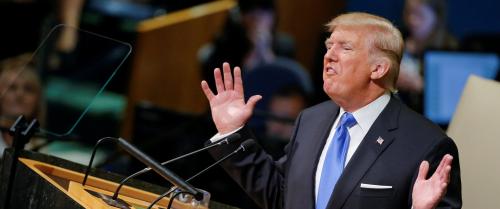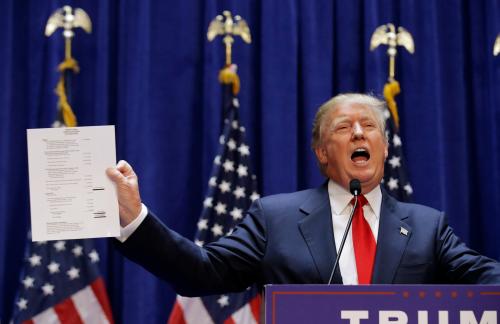This article originally appeared in Marketwatch on September 26, 2017.
Senate Republicans last week agreed on a budget resolution allowing a $1.5 trillion increase in the federal deficit over the next 10 years from tax legislation. This resolution paves the way for 51 Republican Senators to enact mammoth tax cuts by September 30, 2018.
Let’s be clear: these are tax cuts, despite their tax reform rhetoric.
As the centerpiece of these tax cuts, President Donald Trump has proposed to lower the corporate tax rate to 15% from 35%. However, despite the deficit cushion of $1.5 trillion allowed by last week’s budget resolution, a 15% rate is totally unrealistic.
Cutting the corporate tax rate to 15% would cost the U.S. Treasury $3.7 trillion over 10 years. But that cost cannot come close to being offset by repealing existing tax preferences, which all will be fiercely defended by special interests. A realistic legislative target would be a corporate tax rate of 25%. And under Senate rules this rate would have to expire after 10 years because it creates future budget deficits.
Let’s do the math on corporate and individual rates, together with optimistic assumptions about limiting existing tax preferences. The numbers are based on dynamic estimates from the nonpartisan Tax Policy Center, unless noted otherwise.
First, Trump’s proposal to cut the corporate tax rate from 35% to 15% will cost taxpayers $2.3 trillion in forgone tax revenues over the next 10 years. An additional Trump proposal would allow business income received by owners of pass-through entities, such as partnerships or LLCs, to be taxed at 15% rather than the higher rate on ordinary income earned by individuals. If this proposal excluded business income from large partnerships — a tough political sell — it would cost $1.4 trillion over 10 years. So the total revenue loss from a 15% cut would be at least $3.7 trillion.
Now, let’s see if that deficit can be reduced enough by limiting the existing tax preferences of business. To start, suppose all of the current targeted tax breaks for specific industries could be repealed. This would include: taxing incentive fees of hedge fund managers as ordinary income, not capital gains; repealing the special deductions for domestic oil and gas production, as well as eliminating tax credits for renewable energy and low-income housing. Best-case scenario: those raise $270 billion in tax revenues over 10 years.
Suppose further we could limit deductions by businesses to 50% of the interest paid on bonds or loans. This limit would mitigate the tax code’s tremendous bias in favor of debt over equity financing. In my view, this limit could optimistically raise $380 billion over 10 years — after politically necessary exemptions for interest payments by small businesses and financial institutions.
As part of international tax reform, Trump has proposed to allow foreign profits of U.S. companies, now held abroad under deferral rules, to be repatriated to the U.S. subject to a 10% tax. Revenue raised by a deemed repatriation of foreign profits held abroad in liquid form could bring in around $150 billion over 10 years.
So the total of revenue raisers would be about $800 billion against tax cuts of $3.7 trillion — leaving a net deficit of $2.9 trillion on the business side. That would be $1.4 trillion higher than the $1.5 trillion allowed by the current budget resolution.
Alternatively, can the deficit constraint of the budget resolution be met by increasing revenues more than tax cuts on individuals?
Let’s run the math on the individual tax cuts proposed by Trump — $2 trillion for cutting individual rates to 35%, 25% and 10% for the relevant income brackets. Add $450 billion for the permanent repeal of the alternative minimum tax, plus $700 billion for doubling the standard deduction. These cuts together total $3.15 trillion.
What about the individual revenue raisers proposed by Trump — are they big enough to offset $3.15 trillion? Repealing the head of household filing status is worth $200 billion over 10 years. Repealing personal exemptions is the biggest revenue raiser on the individual side — worth $1.65 trillion over 10 years. But together these total only $1.85 trillion.
What else could raise revenues on the individual side? Trump is against limiting deductions on mortgage interest and charitable donations. Instead, he is talking about limiting other deductions, mainly the one for state- and local taxes. In my view, that limit could raise at most $1.5 trillion over 10 years — if it can jump some high political hurdles.
In other words, taking an extremely optimistic view, individual tax changes could raise $200 billion over 10 years — $3.15 trillion negative and $3.35 trillion positive ($1.85 trillion + $1.5 trillion). That $200 billion reduces the net deficit of the whole tax package to $2.7 trillion, instead of the $2.9 trillion from just the business changes.
So how could we reduce that $2.7 trillion deficit by roughly $1.2 trillion to meet the $1.5 trillion limit in the recent budget resolution? It turns out that if the corporate tax rate is cut to 25% from 35%, rather than 15%, that change alone would reduce the cost of the proposed tax cuts by $1.2 trillion over 10 years.
In short, even with wildly optimistic assumptions on closing existing tax preferences, a 15% rate for corporate income taxes is not consistent with the recent budget resolution, which is needed to pass tax legislation by only 51 votes in the Senate. Although the U.S. corporate tax rate is much too high, we may have to settle for a 25% rate in order to enact tax legislation this fiscal year. In politics, the best is often the enemy of the good.
Robert Pozen has been a nonresident senior fellow at Brookings since 2010. In 2015, he generously committed to endow the Director’s Chair for the Urban-Brookings Tax Policy Center. Until 2010, Pozen was executive chairman of MFS Investment Management and, before 2002, served in various positions at Fidelity Investments. He did not receive financial support from any firm or person for this article or from any firm or person with a financial or political interest in this article. He is currently not an officer, director, or board member of any organization with an interest in this article.










Commentary
Op-edWhy the Trump tax plan’s fuzzy math doesn’t add up
September 29, 2017